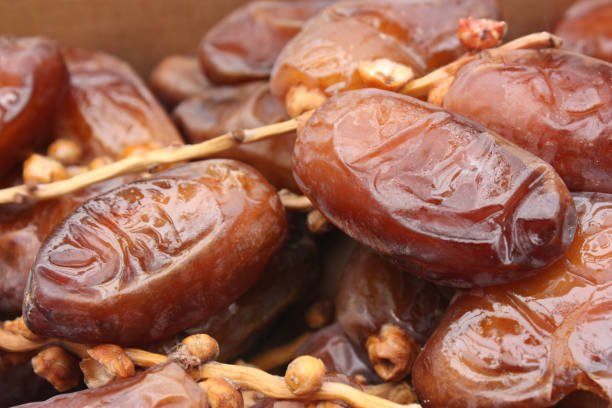
Kurma Tangkai: A Journey Through Dates and Their Ancient Origins
The world of dates is vast and diverse, offering a multitude of flavors, textures, and cultural significance. Among these delightful varieties, Kurma Tangkai, also known as Deglet Nour dates, holds a special place, particularly in countries like Tunisia and Malaysia. But where do these sweet treats come from, and how long have they been gracing our palates? This blog post delves into the intriguing story of this date variety and embarks on a historical expedition to uncover the fascinating origins of the date fruit.
Unveiling the Allure of Kurma Tangkai
Kurma Tangkai, meaning “stalk dates” in Arabic, refers to a specific variety of dates grown in Tunisia. These dates are characterized by their:
- Distinctive Appearance: Unlike some other date varieties, Kurma Tangkai are typically harvested while still attached to the stalk, hence their name. This unique presentation adds a rustic charm and visual appeal to these dates.
- Amber Hue: Their skin boasts a stunning amber hue, often flecked with golden highlights.
- Sweet and Succulent Flesh: Beneath the beautiful skin lies a soft, succulent flesh that offers a delightful balance of sweetness and a subtle caramel-like flavor.
These dates are not only revered for their taste and appearance, but they also possess a rich nutritional profile, being a good source of fiber, potassium, and magnesium.
A Journey Through Time: Tracing the Origins of the Date Fruit
The history of date cultivation stretches back millennia, weaving a fascinating tapestry across various civilizations. Here’s a glimpse into the remarkable journey of dates:
1. Early Traces: Archaeological evidence suggests that date palm cultivation dates back to 7000 BC in Mesopotamia, the region between the Tigris and Euphrates rivers.
2. Ancient Civilizations: Dates played a significant role in the lives of ancient civilizations like the Egyptians, Babylonians, and Assyrians. They were considered a valuable source of food, and their significance extended to religious and cultural practices.
3. Spread and Evolution: Over the centuries, date cultivation spread across various regions, including North Africa, the Arabian Peninsula, and the Mediterranean. Each region developed unique cultivation techniques and fostered distinct date varieties, including Kurma Tangkai in Tunisia.
4. Modern Cultivation: Today, date palm cultivation remains a vital part of the agricultural landscape in many regions, with countries like Egypt, Saudi Arabia, and Iran being major producers.
Modern Cultivation: A Technological Transformation
While the date palm’s cultivation history stretches back millennia, modern agricultural advancements have significantly transformed the way dates are grown. Here’s a closer look at some key aspects of modern date palm cultivation:
1. Advanced Irrigation Techniques: Traditional flood irrigation, while still practiced in some regions, is being replaced by more efficient methods like drip irrigation and micro-sprinkler systems. These techniques allow for precise water delivery, minimizing water waste and optimizing resource utilization in often arid environments.
2. Improved Pollination Practices: Historically, date palm pollination relied on natural wind dispersal or manual hand pollination, which could be labor-intensive. Modern practices, like using pollen guns or controlled pollination techniques, improve efficiency and ensure better fruit set, leading to higher yields.
3. Mechanization and Automation: Modern date farms are increasingly incorporating mechanized harvesting techniques. Machines can gently shake the date palms, loosening the ripe fruits, which are then collected on large nets or mats. This reduces reliance on manual labor and ensures faster harvesting, especially for tall trees.
4. Disease and Pest Control: Modern agriculture has developed effective methods for controlling date palm diseases and pests. This often involves integrated pest management (IPM) strategies that combine biological controls, targeted pesticides, and monitoring programs to minimize reliance on chemical treatments.
5. Greenhouse Technology: In some regions, controlled-environment greenhouses are being used for date palm cultivation. These greenhouses allow for precise control over temperature, humidity, and light exposure, potentially increasing yields and improving fruit quality.
6. Technological Advancements: Modern date farming also benefits from technological advancements like satellite imagery and sensor technology. These tools allow farmers to monitor soil moisture, track crop health, and optimize resource management practices for their date palms.
It’s important to note that not all date farms utilize all these technologies. The level of modernization depends on factors like farm size, budget, and regional practices. However, these advancements are transforming date cultivation, making it more efficient, sustainable, and capable of meeting the growing global demand for this delicious and nutritious fruit.
Conclusion: A Sweet Legacy for the Future
The story of Kurma Tangkai and the date fruit, in general, is an inspiring testament to their enduring appeal and historical significance. From their ancient origins to their contemporary presence in diverse cultures and culinary traditions, dates continue to captivate our taste buds and enrich our understanding of the world’s agricultural heritage.
Key Highlights:
- Kurma Tangkai, meaning “stalk dates,” is a unique date variety from Tunisia.
- Dates boast a long and fascinating history, dating back to 7000 BC.
- Ancient civilizations like the Egyptians and Babylonians valued dates for both food and cultural significance.
- Date cultivation remains an important agricultural practice in various regions of the world, with Kurma Tangkai being a distinct variety from Tunisia.